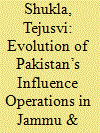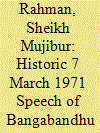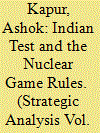| Srl | Item |
| 1 |
ID:
191589


|
|
|
|
|
| Summary/Abstract |
This Article reviews Kerala’s efforts to check the spread of novel coronavirus (COVID-19) without additional expenditure or infrastructure and employing the state police forces. This was remarkable in the face of the fact that healthcare systems were stretched the world over and were struggling beyond capacity to treat the number of people affected by the virus. To add to the overstretched healthcare systems, there were reports of attacks on healthcare workers and facilities. The state of Kerala was among the first to report a coronavirus case in January 2020. Against this backdrop, Kerala’s approach to mobilize the state’s resources, particularly the police, ran counter to that of many other states and their demands for assistance and financial support from the central government. This article details how one state addressed the problem during a national and international crisis. It includes a review of Kerala’s lateral thinking and successful case studies from the field. This research provides strategic thinking and solutions that other states could potentially follow when dealing with pandemics within their borders, both today and in the future.
|
|
|
|
|
|
|
|
|
|
|
|
|
|
|
|
| 2 |
ID:
191587


|
|
|
|
|
| Summary/Abstract |
Influence Operations (IOs) are tailored actions to shape perceptions of a targeted audience within the information domain. They pursue political, economic, social, or military outcomes. Their adaptable transparent nature poses challenges for containment. Pakistan’s IOs, active since Partition, target India a (especially Jammu and Kashmir) through State agencies like the Inter-Services Public Relations and its support to non-State entities. Their objectives vary from destabilization to reshaping the culture of J&K. The Article examines Pakistan’s IOs focussing on core elements: operation narratives and dissemination means for influencing the target audience. It investigates their evolution considering historical roots and categorizing them as ‘Short-term’ and ‘Long-term Projects.’
|
|
|
|
|
|
|
|
|
|
|
|
|
|
|
|
| 3 |
ID:
191592


|
|
|
| 4 |
ID:
191588


|
|
|
|
|
| Summary/Abstract |
As contestation in outer space has evolved into increased militarization since the Cold War era, multiple stakeholders have come to play a significant role in shaping the international regime governing activities of State and non-State actors in outer space. India has interacted with this international regime in a dynamic manner, and currently contributes about 2 per cent to the US$ 360 billion global space industry. Its own security compulsions in outer space are shaped by its national interests vis-a-vis data collection, C4ISR, satellite communications, and of course, deterrence against the rising military might of hostile countries in its neighbourhood—China and Pakistan. In this light, this article looks at the potential of India’s domestic material and policy-based space architecture, including the functioning of ISRO and its collaboration with the private sector, as well as India’s current space-based assets and ASAT capabilities. On the basis of this assessment of India’s current institutional and infrastructural assets for outer space, the article also attempts to chart a trajectory forward for India’s space policy and counter-space capabilities.
|
|
|
|
|
|
|
|
|
|
|
|
|
|
|
|
| 5 |
ID:
191590


|
|
|
|
|
| Summary/Abstract |
The Pokhran test carried out by the Indian Atomic Energy Commission on 18 May 1974, by and large, evoked predictable reactions. Those countries that had come to accept the conventional wisdom on the issue of nuclear proliferation expressed regrets ranging from mild to profound. Some Third World countries expressed satisfaction but Pakistan reacted very strongly. The Indian Government’s declaration that the test was part of a series to exploit nuclear explosive technology and that India did not intend to manufacture nuclear weapons was accepted by many governments, while others expressed varying kinds of reservations about it. Within the country, we were proud of the achievements of our scientific and technological community and angry at what we considered to be double standards of those who muted their protests about the tests of the five nuclear weapon powers but came out loud against the safe and well-contained test at Pokhran. Since then, the declaration that this country does not intend to manufacture weapons has been repeated in many forums, both inside and outside the country. At the same time, India’s right to conduct peaceful underground explosions for developing technology has been reasserted and it has been pointed out that this country did not break any treaty but had reserved the right to carry out these explosions since 1967, when it had protested against the prohibition of such peaceful explosions under the Non-Proliferation Treaty. This was one of the reasons why India abstained from that treaty.
|
|
|
|
|
|
|
|
|
|
|
|
|
|
|
|
| 6 |
ID:
191591


|
|
|
|
|
| Summary/Abstract |
It is possible to argue that India’s nuclear strategy seems to have changed, but this does not necessarily at present mean a change in the fundamentals of India’s nuclear policy as these were outlined in the late 1940s and the 1950s. The nuclear test appears to have damaged the NPT, and the test implies a re-orientation in India’s relations with China and the Super Powers.
|
|
|
|
|
|
|
|
|
|
|
|
|
|
|
|